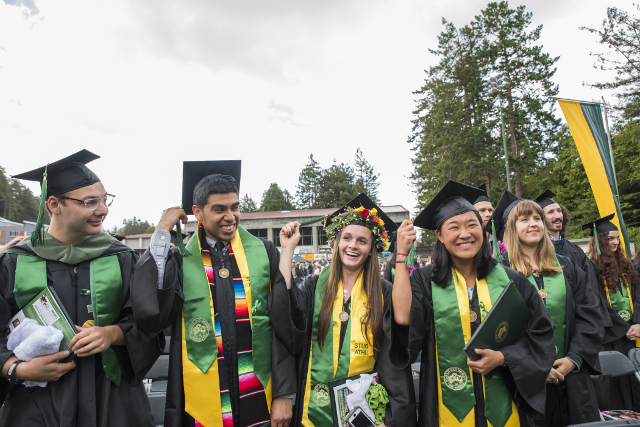
The results of the NSSE, a highly regarded survey administered at hundreds of universities nationwide by the University of Indiana’s Center for Postsecondary Research, shed light on students’ academic behavior, experiences, and perception of the campus environment. They also give HSU another tool to enhance curriculum, budgets, and the campus environment, all of which facilitate student success.
Nearly 450 HSU students participated in the survey—151 first-year students and 298 seniors. It was conducted at the end of the Spring 2017 semester. Consisting of 39 in-depth questions, the survey touched on academic challenges, learning with peers, experiences with faculty, and campus environment.
Associate Vice President of Institutional Effectiveness Lisa Castellino has been analyzing the results of the survey and shared preliminary data with the campus community recently. Castellino looked at how students reported their study habits (for example, 30 percent of first-year students spent 16 hours or more per week studying for class; 48 percent of seniors did the same), indicating that students achieve a sort of balance between work, life, and school as they become more familiar with the requirements of succeeding in class.
Castellino also compared the responses of HSU’s seniors with those of 13 other California State University campuses that took part in the survey this year. The results were generally positive, showing that HSU rated significantly higher in areas such as connecting learning to societal problems, including diverse perspectives, and helping students examine the strengths and weaknesses of their views on issues.
HSU survey respondents said HSU generally ranked higher in collaborative learning, quantitative reasoning, student-faculty interactions, and quality of interactions with faculty, students, and other staff.
HSU also highly outranked peer CSU campuses in students’ “high impact learning” opportunities. These include senior capstone projects, service learning programs, internships or field experience, research with faculty, learning communities and study abroad programs. Nine in 10 HSU seniors had taken part in at least one high impact practice, and eight in 10 seniors had participated in two or more, far outranking the results at other CSUs.
Areas where HSU ranked significantly lower than the CSU average were interacting with people with different political beliefs, helping students manage non-academic responsibilities, and supporting overall wellbeing with recreation, health care, counseling, and similar. Castellino suspects that, being a residential campus in a remote rural area, students may not have access to the same off-campus wellness opportunities as students who go to school closer to their homes.
Castellino points out that there is room for improvement, especially in the areas where HSU ranked lower than the CSU, but also in areas that show relative success. The survey results are a way for the entire University—faculty, staff, administrators, and students—to identify both strengths and opportunities for change and growth.
“The only way to grow and change and to be the University we want to be, and to serve the students of the state of California, is to inform decisions and help us understand where to focus our energy,” she says.
The survey results can be used to enhance strategic budgeting, curricula, and more, also giving a measure of the return on investment of various campus programs.
Generally, Castellino says, the survey results reflect what HSU promises prospective students. “It’s more than an education, it’s an experience,” she says. “The skills they learn here translate to jobs, and HSU instills a set of values on students, helping them look outside themselves.”
Institutional Effectiveness will continue to analyze the results of the study, comparing it to other campus surveys and doing “deep dives” into the results of the campus diversity portion of the survey in the future. The full report is expected to be available on the Institutional Effectiveness website in December.
Two preliminary reports are available now by clicking the following links: The HSU results snapshot (PDF), a concise collection of key findings about HSU’s NSSE survey; and the HSU Pocket Guide (PDF), an overview of key findings for prospective students.
About the National Survey of Student Engagement:
NSSE annually collects information at hundreds of four-year colleges and universities about student participation in activities and programs that promote their learning and personal development. The results provide an estimate of how undergraduates spend their time and what they gain from attending their college or university. Institutions use their data to identify aspects of the undergraduate experience that can be improved through changes in policy and practice.
NSSE has been in operation since 2000 and has been used at more than 1,600 colleges and universities in the United States and Canada. More than 90 percent of participating institutions administer the survey on a periodic basis. Visit their website: nsse.indiana.edu